
Summer is a time for rest and relaxation for many of us. When it comes to lawn care, however, there’s no such thing as a vacation. Although lawn care might look different depending on what type of lawn you have, it doesn’t change the fact that your lawn probably needs tender loving care to get through the summertime. But how do you best care for your lawn during these hotter, harsher months? Here is a summer lawn care guide to walk you through it:
Warm-Season vs Cool-Season Summer Lawn Care
Your summer lawn care routine will depend on what turfgrass you have and what your area’s climate is like.
“Know[ing] what kind of grass you have is the first thing,” says Ron Meyer, agronomist and crop production agent with the Colorado State Extension Service in Phillips County. While knowing exactly what turf species you have is important, you’ll be fine if you only know what type of grass you have: cool-season or warm-season.
How do you figure out if your lawn has warm-season or cool-season grass? Typically, northern states have cool-season grass, and southern states have warm-season grass. But what if you’re in the transition zone? A good way to know is by observing your lawn’s growth cycle. Does your grass grow more in the summer, spring, or fall? Let’s look at the two types of turfgrasses.
Warm-Season Grass
According to Texas A&M University’s AgriLife Extension, warm-season grasses grow best when air temperatures hover in the 70s. This grass type also typically handles drought better than cool-season grass.
The growth chart for warm-season grasses throughout the seasons looks like a simple curve. They start ramping up their growth once warmer temperatures come in February and March, peaking at around June to July. When temperatures start getting cooler, their growth slows down; this usually happens around late summer and continues throughout the fall and winter months.
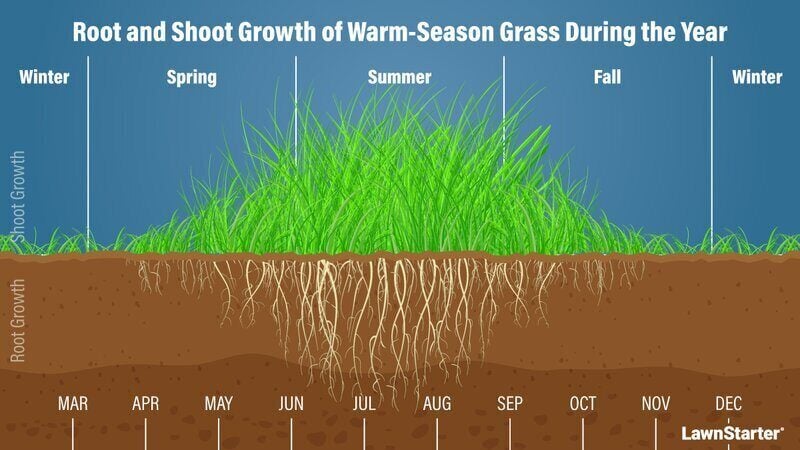
Because of this, the brunt of warm-season lawn care falls within the summer months when warm-season turf is actively growing. Here are some of the most popular warm-season grasses:
- Zoysiagrass
- Bermudagrass
- St. Augustinegrass
- Centipedegrass
- Buffalograss
- Bahiagrass
- Carpetgrass
Cool-Season Grass
On the other side of the fence, we have cool-season grass. According to Texas A&M, cool-season lawns thrive when air temperatures are in the 60s.
Cool-season turf growth inverts that of warm-season grass. Cool-season grass types grow vigorously in spring and fall and slow down in the summer. Their growth typically peaks in April and then again in October. These grass types typically handle the cold better than warm-season grasses.
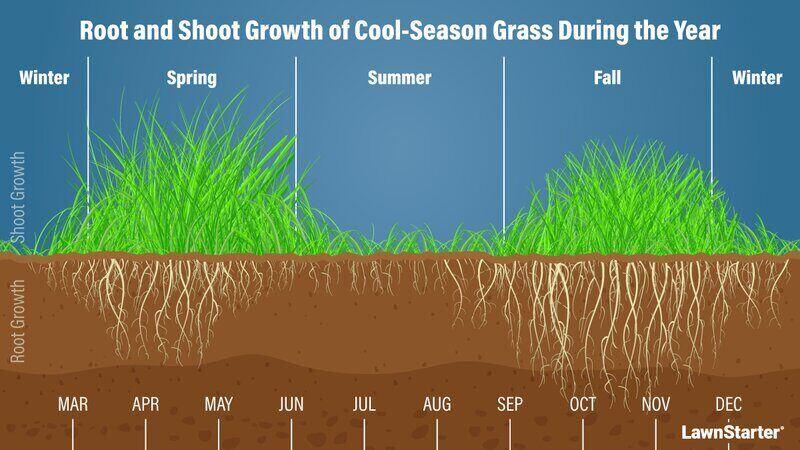
Most cool-season lawn care happens in the spring and fall. In the summer, homeowners typically only need to water, mow, and clean their cool-season turf. Here are some of the most popular cool-season grasses:
- Kentucky bluegrass
- Tall fescue
- Fine fescue
- Perennial ryegrass
- Bentgrasses
Mow High and Mow Properly
This summer, you should let your grass grow a little taller and mow high. Mowing your turf high encourages strong root growth, which helps your lawn become more heat-tolerant and drought-resistant. Taller grass also provides more shade that discourages weeds from growing and cools your soil down a little.
For warm-season grasses, you should set your mowing height between 2 to 3 inches high.
Cool-season grasses should be mowed even higher – no shorter than 3 inches tall.
When you mow, try not to take off more than ⅓ of your grass blades’ height. Any more than ⅓ can cause unnecessary stress on your lawn. Stress can make it easier for pests, weeds, and diseases to latch onto your lawn.
The following tips also go into mowing the lawn correctly.
Sharpen Your Mower Blades

Photo Credit: isuaneye / Canva Pro / License
Make sure to sharpen your mower blades before you rev up your lawn mower this summer. Sharp blades make for a clean and healthy cut; dull blades can cause your lawn to turn brown and sickly. Why does that happen? Instead of cleanly cutting away the top part of the grass blade, dull blades on your lawn mower rip and tear it away. This also stresses your grass out.
Practice Grasscycling
What do you do with those grass clippings after mowing your lawn? Instead of throwing them away, you should reuse them. Called “grasscycling”, reusing lawn clippings can save you some money and leave your turf healthier. You can simply spread the clippings out on your lawn as mulch; it’s even better if you can cut them smaller with a mulching blade.
Mulched grass clippings help maintain moisture levels in your lawn. As they decompose, they even double as a free and natural fertilizer. Just make sure that your grass clippings are dry when you use them. You don’t want them to trap too much moisture, which invites fungi and rot.
If you don’t want to mulch your lawn clippings – or if you’re swimming in them – you can add them to your compost pile instead.
Water Appropriately
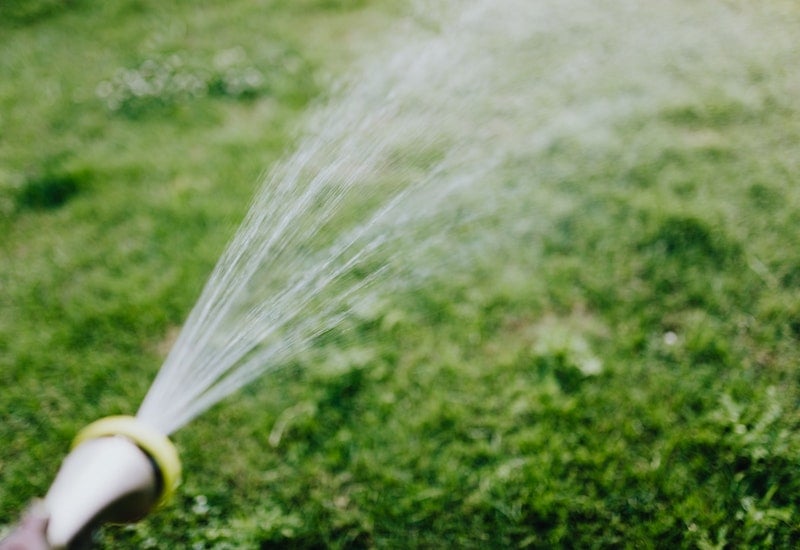
Watering your lawn is key to keeping it alive throughout the summer months. It’s important to know what type of grass you have on your lawn partly because their water needs will be quite different. When temperatures reach 85 degrees, Meyer says, warm-season grass types need about 1 inch of water per week, and cool-season grasses double that.
If cool-season grasses don’t get enough water, they’ll go dormant. While most grasses don’t mind going dormant, dormancy can be more harmful for some grasses like tall fescue, as they can’t recover as fast as other grass types.
Here are some lawn watering tips to help you out:
Water Early
The best time to water your grass is the early morning, between 4 a.m. and 8 a.m. This allows more water to reach the roots, reduces water waste due to evaporation, and gives the grass a chance to dry off. If you water too late in the morning, you can scald your lawn. Avoid evening watering at all costs because your grass will stay wet for too long, inviting fungal diseases.
Avoid Overwatering
You want the water to penetrate 6 to 8 inches deep into the soil. You can find out if you’re over- or underwatering by driving a small tool, like a screwdriver or small trowel, into the soil. If the soil is dry and you’re having a tough time getting it through, then you’re underwatering. If it slips right in, you’re overwatering.
You can figure out how long to run your sprinklers using the tuna can trick. Get a bunch of straight-sided cans – tuna or cat food cans work well – and place them around your sprinklers. Set a timer and let your irrigation system run until the water reaches your desired amount. The time it takes to fill the cans to your desired amount is how long you should let your sprinklers run. You could also invest in a rain gauge.
Lastly, don’t water every day. Once or twice a week is enough even during drought conditions. Watering deeply and infrequently promotes a strong root system that can handle drought better. Watering too often leads to shallow roots.
Keep an Eye on Your Grass
Your grass will show signs when it’s not getting enough water. These signs include:
- Grass blades fold up
- Wilting
- Grass turns blue-gray
- Footprints don’t disappear after you walk on the grass
Mind the Rain
Keep an eye on the weather forecast! Try not to water if it’s expected to rain in the coming days; that way, you’ll save water and avoid overwatering. In the same vein, don’t water after it has rained. Meyer says a good rule of thumb is that if you get an inch of rain, take about five days off from watering. If you get less than that, lay off only for a few days.
Leave Dormant Grass Alone
If your grass does go dormant, don’t worry too much. It’s best to leave it alone than to try and water it back to life. Reduce the amount of water you give your warm-season grass to ½ to ¼ inch of water once or twice a week. For cool-season lawns, reduce to around ½ inch of water every two to four weeks, just enough to get them through the summer drought.
Your turf is quite sensitive when it has gone dormant. Refrain from mowing, stepping on, or parking on it, too.
Fertilize Your Warm-Season Lawn
Since summer is the prime growing season for warm-season grasses, it’s the best time for warm-season lawn fertilization. Feed your turf with a slow-release fertilizer in the early summer so that it gets the nutrients it needs to thrive.
Just make sure not to apply too much, as your grass can burn. This is especially true mid-summer; the new growth won’t be able to handle the hot weather. You can fertilize again in late summer around Labor Day.
Don’t fertilize if you have a cool-season lawn. Cool-season grasses should be fertilized in the fall and then again in the spring.
Already know what type of grass you have? Check out our guides below so that you can develop a summer fertilization schedule for your warm-season lawn:
- When to Fertilize Centipedegrass
- When to Fertilize Buffalograss
- When to Fertilize Zoysiagrass
- When to Fertilize Bermudagrass
Keep on Top of Pest Control
The warm temperatures can bring pests out of the woodwork. Depending on where you live, summer pests could include June beetles, chinch bugs, cutworms, armyworms, and sod webworms.
Some of the most destructive lawn pests around are white grubs. These beetle grub larvae will eat through your turf’s roots, leaving the grass blades behind. Turf ravaged by lawn grubs can leave brown spots, and you can easily lift affected grass from the soil, as it doesn’t have a root system to keep it in the soil anymore. You might even be able to see these pests curled up and resting.
Treat your lawn for pests early in the summer to beat the heat. Spot-treat rather than applying pesticides everywhere as much as possible, as pesticides can damage your grass during drought conditions. Always read the label before using pesticides, or consider contacting a pest control company to get rid of these unwelcome visitors.
Watch for Weeds and Diseases
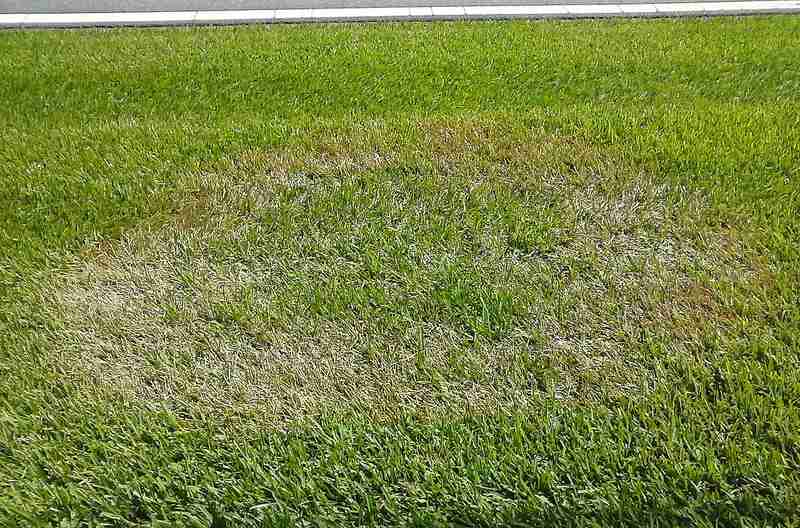
Photo Credit: Scot Nelson / Wikimedia Commons / CC0 1.0
In the summer, weeds might set up shop on your lawn. Spot-treat with post-emergent herbicide as much as possible; most herbicides target broadleaf plants, which can include shrubs, trees, crops, and flowers.
Like with pests, control weeds early in the season and avoid using herbicides when it’s 85 degrees or higher outside. Don’t mow before or after applying weed control products so they can reach the offending plants. Don’t apply herbicide before or after it rains, either, or else your herbicide won’t stick. Lastly, avoid applying herbicide during drought conditions, as this can seriously affect turf health.
Summer is also the prime time for some lawn diseases like brown patch, summer patch, and rust. As always, read the label before using a fungicide to make sure you’re using it correctly and safely. Spot-treat for fungal diseases as much as possible.
Keep Your Lawn Clean
Dogs are man’s best friend, but they can be your lawn’s enemy. When your pooch defecates in your yard, pick up after them, or else you might find yourself with brown spots on your lawn. Urine can also cause brown spots to appear on your turf; flush it out with water after your pet finishes peeing.
Even better than cleaning up after your furry friends is teaching them to do their business off of your lawn, like in a pebbled area.
Animal waste isn’t the only thing you should remove from your yard. Pick up any litter you find; put away any tools and toys left on your lawn, too.
Aerate Your Lawn
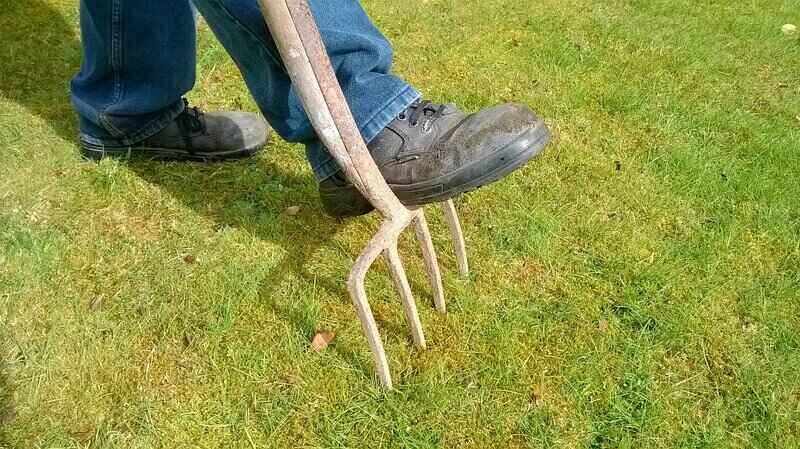
Throughout the year, your lawn’s soil will get compacted, restricting the flow of nutrients, water, and air to your turf’s root system. Aerating your warm-season lawn loosens up your soil so that this doesn’t become an issue anymore.
It’s not required to do this in summer; in fact, it might be better for some lawns to be aerated in the fall or spring. If you decide you want to aerate this summer, do it in the last few weeks of the season. Don’t aerate cool-season lawns in summer.
Overseed If Needed
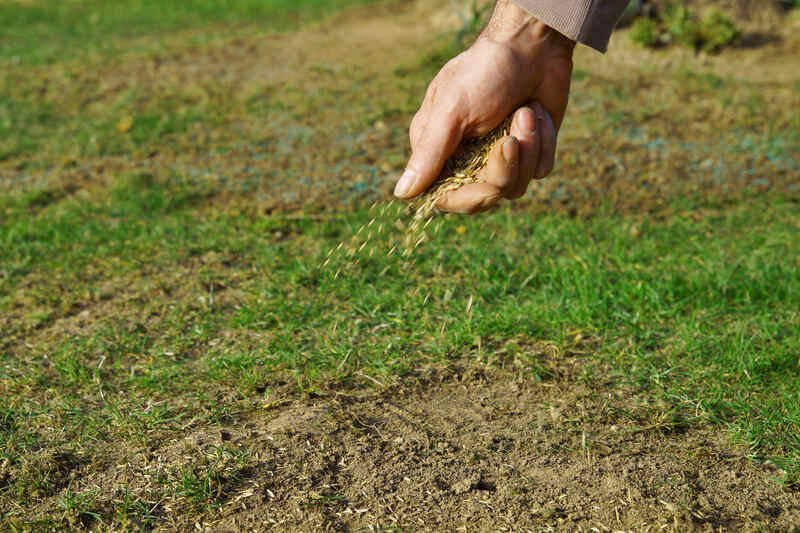
Is your lawn looking a little patchy or thin? Early summer is the best time of year to overseed warm-season turf. Overseeding early in the season encourages the new grass to grow. Just keep in mind that the new turf should be watered frequently for the first few weeks until it can establish itself. Hold off on fertilizing your new grass as well. It’s better not to fertilize and overseed at the same time.
FAQs About Summer Lawn Care
You should aerate cool-season grass in the spring or fall when it’s actively growing. Lawn aeration can damage your turf a little, so do it when your grass can regrow and recover.
If you want to dethatch your warm-season turf, early summer is the time to do it. If you have a cool-season lawn, hold off until the fall or next year’s spring to dethatch your lawn.
There are a few ways to make your lawn less thirsty. Pick drought-tolerant grass and plants; look into getting some native plants in your yard as they’re well-adapted to the climate of your area.
You can also consider xeriscaping, which is a step up from just using drought-tolerant plants. Xeriscaping also makes creative use of hardscaping to create a beautiful yard that doesn’t use up as much water as a traditional lawn does.
If you’re feeling the heat, why not add some trees to your yard? Trees can help cool down homes. However, you should do your research before planting, as not all trees will be beneficial to your property. For example, some of them can be really thirsty and large, like weeping willows.
Keep Your Lawn Healthy in the Summertime
Drought, pests, weeds, and disease, oh my! Summer can bring these challenges to your lawn, but following these summer lawn care tips will keep these issues at bay.
If you’d rather enjoy your summer on the beach or at the lake, why not hire a local lawn care company to do the work for you? Now, you won’t have to pick between having a lush and healthy lawn and a relaxing weekend. Connect with a local lawn care service on LawnStarter today!
Main Image Credit: Pxfuel